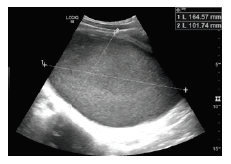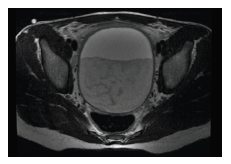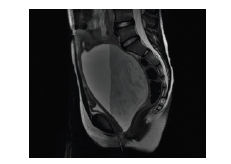A previously healthy 12-year-old girl presented to the Pediatric Emergency Department complaining of urinary retention, suprapubic pain, and dysuria for two days. She denied fever or gastrointestinal symptoms. Physical examination showed a suprapubic mass compatible with a painful vesical globe and the remaining physical examination was normal. Urine culture was performed to assess a potential cystitis diagnosis, which was positive for multisensitive Escherichia Coli. The girl was discharged medicated with amoxicillin and clavulanic acid. She returned three days later (day 2 of antibiotics) complaining of persistent urinary retention, fever, and vaginal bleeding. She had had her menarche three months before and her last menses occurred during the last fortnight. Upon gynecological examination, diagnosis of microperforated hymen was established. Pelvic ultrasound revealed a hypoechogenic nodular formation with approximately 20 cm in diameter (Figure 1), well defined and homogeneous; uterus and ovaries were not visible, probably pushed by the massive formation. This formation was confirmed by magnetic resonance imaging, which showed a massive lesion occupying space, with well-defined contours and pre-thickened, reaching 16.2 x 9.7 x 8. 9 cm in longitudinal, anteroposterior, and transverse axes, respectively. The lesion had a heterogeneous fluidic content without hypervascularized components in the lesion lumen (Figures 2and3). No changes were detected in the urinary system.
Discussion
The girl underwent vaginoscopy and hymenectomy, showing a piohematocolpos which was completely drained. She was revaluated two weeks later, with complete condition resolution.
Hematocolpos is an accumulation of menstrual blood in the vagina, resulting from genital tract obstruction. It is a rare condition that occurs in adolescence, usually secondary to an imperforate or microperforate hymen. This is one of the most common congenital anomalies of the genital tract, and consists of a connective tissue membrane covered by epithelium obstructing the vaginal opening at the introitus level. Hymen is a membrane that usually develops embryologically through fusion of the caudal end of the paramesonephric ducts and the urogenital sinus. The central portion of this membrane perforates through degeneration of epithelial cells. Failure of epithelial cell degeneration and subsequent perforation leads to a hymen that is termed imperforate.1 The differential diagnosis includes transverse vaginal septum, longitudinal vaginal septum, vaginal agenesis, and cervix atresia.2 Symptoms as abdominal pain, dysuria, urinary retention, or amenorrhea can be present, and diagnosis implies a high degree of suspicion.3 Menstrual history and inspection of the external genitalia showing a bluish-colored hymen should be part of the evaluation and aid in diagnosis.4 Surgery is the recommended treatment, consisting of an incision in the vaginal hymen, and should be performed as early as possible to relieve symptoms and prevent complications.5
Lessons from this clinical case
All healthcare professionals attending adolescents should be alert for possible gynecological pathology.
Although hematocolpos is a rare condition, it should be considered in presence of an abdominal mass, for proper guidance.
Rapid recognition allows for timely surgical intervention, preventing complications


















